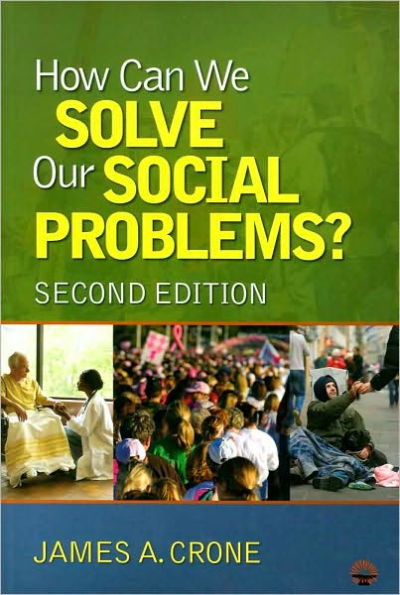Table of Contents
Preface ix
About the Author xi
Acknowledgments xiii
1 Preparing to Solve Our Social Problems 1
What Is a Social Problem? 1
History of Studying Social Problems 2
Teaching About Social Problems in Today's World 4
How Can Sociologists Address Social Problems and Yet Remain Objective? 5
What Social Problem Should We Solve First? 7
How Might Sociological Theory Help Us to Solve Social Problems? 8
A Theory of Conflict and Social Change: A Way to Better Understand and Therefore Solve Our Social Problems 10
Causal Model: A Picture of Our Theory 15
My Own Theoretical Orientation 17
Other Sociological Theories That Can Help Us Understand and Solve Social Problems 17
Concluding Thoughts on Theory and Social Problems 23
Addressing Social Problems Within Capitalism 23
The Next Chapter 23
Questions for Discussion 24
2 Barriers, Possibilities, and How Sociology Can Help 25
Barriers to Solving Our Social Problems 25
Possibilities for Solving Our Social Problems 36
How Can Sociology Help to Solve Social Problems? 42
Questions for Discussion 46
3 How Can We Solve the Problem of Increasing Inequality? 49
Definition and Statistics 49
Causes of Growing Inequality 51
Consequences of Growing Inequality 55
Options We Have With Inequality 56
What Should We Do? 60
Questions for Discussion 61
4 How Can We Solve the Problem of Poverty? 63
Assumptions We Can Make About Solving Poverty 63
What Can We Do? 66
Concluding On an Optimistic Note 80
Questions for Discussion 81
5 How Can We Solve the Problem of Racial/Ethnic Inequality? 83
Now, and Where to Next? 86
What Might Racial/Ethnic Equality Mean? 88
What More Can We Do? 88
Questions for Discussion 98
6 How Can We Solve the Problem of Gender Inequality? 101
What Can We Do? 103
Concluding Thoughts 114
Questions for Discussion 114
7 How Can We Solve the Problem of Unequal Education? 117
What Can We Do? 117
Problems That Prevent Us From Having Excellent Public Schools 120
Tax Money for Schools 121
Positive Consequences 122
What Will Not Work If We Want Excellent Public Education: The Voucher System 123
Questions for Discussion 126
8 How Can We Solve the Problem of Crime? 127
What Can We Do? 129
A Dilemma: Capitalism and Crime 137
Questions for Discussion 139
9 How Can We Solve the Problem of Drugs? 141
Keep the Current Policy 142
Legalize Drugs for Adults 146
Take a Step-by-Step Approach by Legalizing One Drug at a Time 150
Where to Go From Here? 152
Questions for Discussion 152
10 How Can We Solve the Problem of Health Care? 155
Consequences of Our Problem 156
Why Don't We Have a National Health Care System Like All Other Industrial Nations? 158
Criteria for a New Health Care System 162
Elements of a New Health Care System to Satisfy These Criteria 163
Advantages of a National Health Care System 169
Disadvantages and Costs of a National Health Care System 172
What Other Countries Include in Their National Health Care Systems 173
The Future: What Could Happen? 178
Summer and Fall 2009 and Winter 2010: Finally, Serious Debate 180
March 21, 2010: Health Care Reform Passes Congress 182
Questions for Discussion 184
11 How Can We Solve the Problems of Families? 185
Decreasing Inequality to Help Families 185
Decreasing Poverty to Help Families 186
Creating Enough Jobs and Enough Decent-Paying Jobs 186
Creating Racial/Ethnic Equality to Help Families 187
Creating Gender Equality to Help Families 189
Including Gay and Lesbian Couples to Help Families 189
Decreasing Crime to Help Families 191
Changing the Way We Deal With Drugs to Help Families 192
Creating a National Health Care System to Help Families 193
Creating Good-Quality Education for All Students to Help Families 194
Educating Students to Help Families 194
Educating Parents to Help Families 195
Summary of What We Can Do to Help Families 196
Questions for Discussion 196
12 How Can We Solve the World's Population Problem? 199
Causes of the World's Population Problem 200
What Can We Do? 204
Where Are We? 208
Questions for Discussion 209
13 How Can We Solve the World's Environmental Problem? 211
Consequences 213
What Can We Do? 215
Conclusion 226
Questions for Discussion 228
14 Solving Our Social Problems: Predictions and Conclusions 229
A Number of Similar Social Conditions 229
Defining a Social Condition as a Social Problem 229
Legitimation 230
Values and Vested Interests 230
Loss of Control Over the Social Problem 231
Attention and Resources 232
Someone Will Be Dissatisfied 232
Compromise 233
Becoming Accustomed to Social Change 233
Capitalism and Social Problems 234
Environment, Population, and Standard of Living 235
Building a Sustainable Society 236
Conclusion 237
Questions for Discussion 243
Notes and References 245
Index 281









